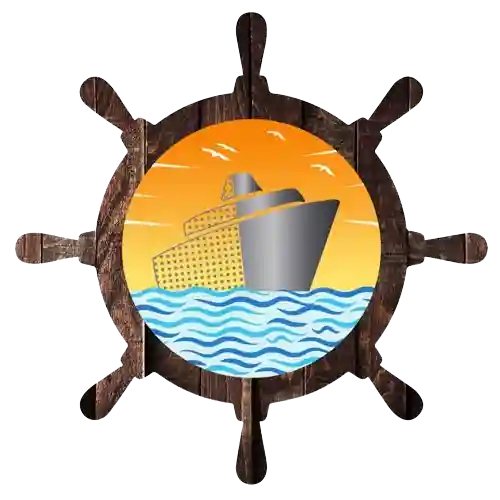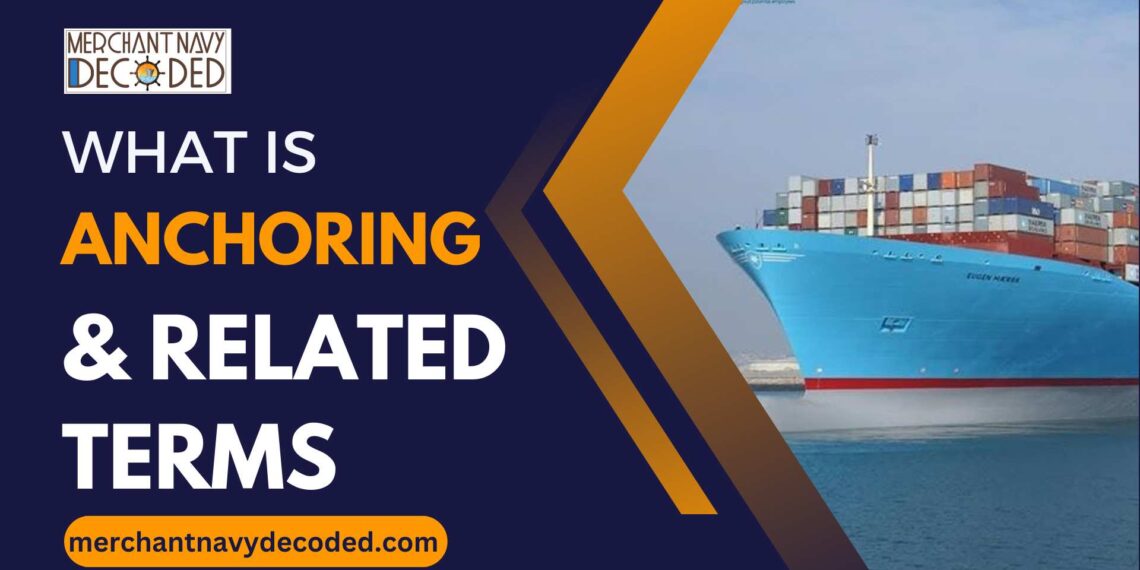Anchor of a Ship & Anchoring Procedure
1. Overview
Anchoring of a ship refers to dropping and securing the anchor of the ship at the seabed to prevent the vessel from drifting from its position when waiting for the berth to become vacant or to enter the port.
2:- What is an Anchor of a Ship
An anchor of a ship is a device similar to a hook attached to a chain called a ship anchor along with the cable holds the ship at its position in reasonable weather conditions against wind and current.

3. Reasons for Anchoring of Ship
When you reach the port, you may need to anchor your ship due to many reasons such as:-
- Before entering the port and waiting for the pilot/berth
- Cargo operation at the anchorage
- Crew change
- Awaiting instructions from owners/ charterers
- To turn the vessel around
4. Parts of the Anchor System of Ship

4.1 Anchor of a Ship
The anchor of a ship is the crucial equipment used to hold the ship at a stable position during anchoring. There are three anchors on board the ship, two on the forecastle ( one on the port side and the other on the starboard side), and one is a spare anchor used in case one anchor is lost.

4.2 Chain Cable of an Anchor
Chain cables provide enough weight to ensure that the anchor lies horizontally on the sea bed and gets the maximum holding force.
The length of the chain cable (steel studs) is measured in shackles, one shackle is equal to 27.5 meters. One shackle is also equal to 15 fathoms or 90 feet.

4.3 Hawse Pipe
The main function of the hawse pipe is to guide the chain from the deck level to the outside of the side plating. Hawse pipe is large enough to accommodate the smooth running of the chain
Hawse pipe provides the secure stowage for the anchor. A Hawse pipe is a structure that enables the anchor to drop freely without jamming and damaging the hull.

4.4 Anchor Lashing
The function of the anchor lashing is to secure the anchor when in stowed position. Anchor lashing prevents the anchor from banging into the ship hull, damaging it, and at the worst part from penetrating it. The method of securing the anchor is called Devil’s Claw comprises the wires and bottlescrew arrangement.

4.5 Chain Stopper
The function of the chain stopper is to guide the chain into the hawse pipe. It transfers the chain forces into the ship’s structure when closed. It is built to withstand 80% of the minimum breaking load of the chain.
The most common type of chain stopper is a rolling type or guillotine type.

4.6 Windlass
It is a machine designed to raise or lower the anchor and has one or more cable lifters or gypsy. Gypsy is a deeply grooved drum that engages the link of the chain. Windlass helps the sailor to lower or raise the anchor more efficiently than the manual method.

4.7 Spurling Pipe
The spurling pipe is the opening in the forecastle deck leading to the chain locker, it is the opening that carries the anchor chain from the gypsy to the chain locker.
4.8 Chain Locker
A chain locker is a compartment located on the bow of a ship under the windlass beneath the forecastle deck. A chain locker is a structure used to store the anchor chain when it is not in use. A chain locker can be made watertight to ensure that the water does not enter the chain locker.
4.9 Bitter End
As the name suggests it is the end, the bitter end is the the end of the anchor chain secured at the chain locker or the hull by a quick-release system. The end is secured at the vessel’s chain locker or collision bulkhead. At the bitter end, sludge is kept for the release of the anchor chain at the time of emergency.

These anchoring equipment are located on the forecastle, the most exposed part of the vessel.
5. Anchor Watch Duties
‘Anchor Watch‘ typically refers to a practice used by sailors to monitor their vessel while at anchor. When a boat is anchored, it is important to ensure that it stays in a fixed position and doesn’t drift or drag anchor. An anchor watch regularly checks the vessel’s position to ensure it remains within a swinging circle.
- While at anchor use should exhibit proper light and sound signals.
- Ensure that a proper lookout is maintained, in case of restricted visibility a separate lookout should be maintained with OOW.
- Ensure the main engine and other machinery are always ready for immediate maneuver.
- Use navigational equipment well, and check and verify the ship positions.
- The watchkeeper should keep observing the weather conditions at all times.
- If OOW finds anything unusual then he should notify the master and take necessary actions.
- Personnel on anchor watch should ensure that antipiracy precautions are taken including regular rounds.
- Maintain a continuous listening watch on the VHF channel.
- Necessary entries shall be made in the logbook at the end of each watch.
6. Ship Anchoring Procedure or Steps of Anchoring
Step 1: Approach the Anchorage:
- Approach slowly at less than 3 knots.
- Ensure the dinghy is secured and the anchor is ready to drop.
- Have a crew member forward to watch for reefs.
Step 2: Prepare for Reef Navigation:
- Use Polaroid sunglasses to see reefs better.
- Avoid approaching the sun to reduce glare.
- Circle the intended anchor spot to check depth and obstructions.
- Approach the spot into the wind or tide.
Step 3: Determine the Scope:
- Check water depth using a depth meter, chart, or lead line.
- Consider the expected increase in depth due to tides.
- Multiply the total depth by 4 to determine the length of the anchor chain. For example, if the total depth is 10 meters, the chain length should be at least 40 meters.
- Use at least 35 meters of chain.
Step 4: Drop the Anchor:
- Stop the ship at the chosen spot.
- Slowly let out the anchor chain as the ship drifts backward with wind and current.
- Allow the boat to move backward until the chain is taut.
Step 5: Set the Anchor:
- Run the engine(s) in reverse at a very slow speed for 5-10 minutes to dig the anchor into the seabed.
- Attach a snubbing rope and let out more chains so the weight is on the rope.
Step 6: Confirm the Anchor Hold:
- Check for vibration in the chain while in reverse; if it vibrates, the anchor may be dragging.
- Look for eddies along the ship’s side caused by prop wash indicating the boat is stationary.
- Take bearings on fixed objects from the bow and beam to ensure the boat stays in position.
Step 7: Ensure Sufficient Swinging Room:
- Ensure your boat is 3-4 ship lengths from the anchor drop point.
- Check for obstructions within the swing radius.
- Monitor the boat’s position against landmarks to ensure the anchor isn’t dragging.
Step 8: Adjust for Conditions:
- In strong winds or unprotected anchorage, let out more chains for better holding.
- Be mindful of battery power if using an anchor winch, as repeated use can drain the battery.
7. Top 20 Anchor Terms Used on Ship
- Anchor ‘a’ cock bill: The anchor hangs vertically from the hawse pipe with the flukes turned into the ship’s side, ready to be dropped.
- Anchor coming home: The anchor is being drawn towards the ship while heaving away with the windlass.
- Anchor aweigh: The anchor is clear of the bottom.
- Anchor dragging: The anchor is not holding the seabed.
- Brought up to three in water / four on deck: The anchor is dropped, with the third joining shackle in the water and the fourth on deck.
- Clear Hawse: Cables are clear of one another.
- Clear anchor: The anchor is hanging from its ring and clear of its cable or any obstruction.
- Clearing anchors: Removing securing gear on deck from anchors and cables.
- Come to, Brought up, Got her cable: Terms used when a vessel is riding to her anchor and cable, and the anchor is holding.
- Foul hawse: Crossing of the anchor cable when using both anchors.
- Foul anchor: An anchor caught in an underwater cable or fouled by its cable.
- Hawse pipe: The pipe where the anchor is stored.
- Long stay: The cable is taut and reaches well away from the hawse pipe, entering the water at an acute angle.
- Short stay: The cable is taut and close to the ship’s side, not overextended.
- Surge cable: Allowing the cable to run out freely.
- Snub the cable: Stopping the cable from running out by applying the brake.
- Spurling pipe: The pipe through which the cable leads to the cable locker.
- Walking back anchor: Lowering the anchor under power.
- Weighing anchor: Heaving in the cable until the anchor breaks out of the bottom
- Yawing: A vessel moving to port and starboard of the anchor position under the influence of wind or tide.
8. Types of Anchors
| Anchor Type | Description | Features | Common Use |
| Plow Anchor | Shaped like a plow with a single blade | Good holding power in various seabeds, including mud and sand | Recreational boats and some commercial vessels |
| Danforth Anchor | Lightweight with wide flukes | Strong holding power in sandy and muddy conditions; folds for storage | Smaller boats and yachts |
| Bruce Anchor | Heavy, with a concave shape | Effective in a wide range of seabeds; reliable holding power | Various types of vessels, including robust anchoring needs |
| CQR (Plow) Anchor | Plow anchor with a swiveling blade | Excellent holding power; performs well in various conditions | Recreational and commercial vessels |
| Kedge Anchor | Smaller, often used for emergency | Lightweight and portable | Emergency or secondary anchoring |
| Fisherman’s Anchor | Flat, heavy design with two large flukes | Good holding power in mud or sand; retrieval can be difficult | Fishing boats |
| Mushroom Anchor | Shaped like a mushroom with a heavy base | Excellent for soft seabeds; slow to penetrate but holds firmly | Mooring systems or small boats in sheltered areas |
| Admiralty Anchor | Heavy-duty with multiple flukes | Exceptional holding power in various seabed conditions | Larger commercial vessels or naval ships |
| Screw Anchor | Features a spiral screw mechanism | Effective in soft seabeds; screws into the sea floor | Permanent mooring or specific anchoring needs |
| Bruce or Claw Anchor | Claw-like design for effective grip | Good for a variety of seabed types, including rock and sand | Yachts and smaller vessels |
9. What is Let Go Anchor?
Let Go command instructs the crew to release the anchor from its stowed position and allow it to drop to the seabed.
Steps for “Let Go Anchor”
- Step 1: Preparation:
- Ensure the anchor and chain or cable are properly prepared.
- Clear any obstructions from around the anchor.
- Step 2: Execution:
- Release the brake on the windlass or anchor winch.
- Allow the anchor to drop by gravity, letting out the specified length of chain or cable (e.g., 20 meters) until the anchor reaches the seabed.
- Step 3: Secure:
- Once the anchor has reached the seabed, engage the brake on the windlass to prevent further movement.
- Verify that the anchor is properly set by checking for a tight chain and ensuring the vessel is holding its position.
- Step 4: Monitoring:
- Continuously monitor the anchor’s position and holding to ensure it remains securely set.
This process ensures that the vessel is properly anchored and ready for safe operations at the designated location.
10. What is Walk Back Anchor

Walking back to the anchor refers to lowering the anchor while the vessel moves slowly in reverse, helping the anchor to set firmly on the seabed.
10.1:- Procedure of Walk Back Anchor
| Step | Description |
| Step 1: Preparation | – Ensure the anchor and chain or cable are properly prepared and ready for deployment. – Clear any obstructions around the anchor. |
| Step 2: Execution | – Begin lowering the anchor by releasing it from the stowed position. – As the anchor is lowered, walk the anchor chain or cable back slowly. This involves using the windlass or anchor winch to control the rate at which the chain or cable is paid out. |
| Step 3: Positioning | – Carefully walk back with the anchor chain or cable to guide the anchor to the desired location on the seabed. – Ensure the anchor is positioned correctly and is allowed to settle. |
| Step 4: Securing | – Once the anchor is on the seabed, engage the brake on the windlass or anchor winch to prevent further movement. – Check that the anchor is properly set and holding the vessel’s position. |
| Step 5: Monitoring | – Continuously monitor the anchor’s position and holding to ensure it remains securely set. – Perform regular checks and adjust as necessary to maintain secure anchorage. |
This process ensures precise control over the anchor’s deployment and positioning, contributing to a secure and stable anchoring of the vessel.
11. Conclusion
Using and taking care of the anchoring system is very important for keeping the vessel in position when it is not in motion or stationary. The crew needs to know how to use and secure the anchor properly. We have to regularly check and resolve the problem regarding the anchor for the smooth functioning of the vessel so that everything works well and keeps us secure.
12. Frequently Asked Questions Regarding Anchor of a Ship
An anchor is a heavy hooked-like structure that is dropped from the boat or ship to keep it in position when it is not moving.
The purpose of a chain locker is to store the anchor chain when it is not in use.
Anchor lashings are used to avoid the anchors being lost while underway at sea.
The hawse pipe leads the anchor chain from the water onto the deck.
Spurling pipe carries the anchor chain from the windlass to the chain locker.
It is the equipment used for lowering and raising of anchor during the anchoring operation.
The bitter end is the end of a rope or chain that fastens to the ship so you don’t lose your anchor.
Disclaimer :- The opinions expressed in this article belong solely to the author and may not necessarily reflect those of Merchant Navy Decoded. We cannot guarantee the accuracy of the information provided and disclaim any responsibility for it. Data and visuals used are sourced from publicly available information and may not be authenticated by any regulatory body. Reviews and comments appearing on our blogs represent the opinions of individuals and do not necessarily reflect the views of Merchant Navy Decoded. We are not responsible for any loss or damage resulting from reliance on these reviews or comments.
Reproduction, copying, sharing, or use of the article or images in any form is strictly prohibited without prior permission from both the author and Merchant Navy Decoded.





Good
Very Great post on Ship Anchor